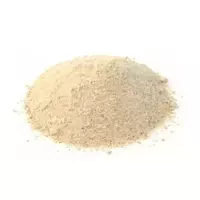Asafetide ground

The asafetida plant belongs to the Umbrella family and has the not particularly sonorous official name Ferula assa-foetida, which sounds like a stink ferula in Latin. Asafetida is a landmark plant for both the food and pharmacological industries. In cooking, a plant rhizome is used, which is ground into powder or milky juice is extracted from it. Asaphetide juice is used to make spice in the form of resin. Asafetida is actively used in Asian dishes.
The asafetide plant can reach up to one and a half meters in height. Asafetida has an extensive root system. The asafetid plant blooms in large inflorescences in the form of umbrellas, which are formed by white small flowers. The homeland of the plant is called such states as: Afghanistan, Iran and Tajikistan. In order to prepare asafetide spice, pickers look for the plant and treat it in a special way. Asaphetida root is rounded and released from the ground, dry leaves are cut off and then sprinkled back with earth. After about a month, the picker returns and does the same action with the plant again.
However, this time the collector makes an incision on the rhizome of the plant and installs a container in which enough milky juice will gather in two days. From one plant, asafetids collect up to 1, 300 grams of fresh latex or milky juice. In cooking, in addition to resin, asafetide is used ground. Often, the spice is called not only ground asafetide, but also ferula or stinking resin, as well as asmargok, hing or ilan. The appearance of asafetida ground is strikingly different from other types of spices.
Ground asafetide is a mixture of different almond-like grains that stick together due to the content of milky juice in the spice. The interesting thing is that at room temperature asafetide is ground soft, like honey or wax. However, as the temperature increases, the aggregate state of the spice changes. From asafetide powder, ground is converted into a viscous and viscous liquid. At a lower temperature, asafetide wax can be shredded into powder without much effort. The taste of asafetida spice is a mixture of garlic and onion flavors.
Asafetida ground is distinguished by its persistent and caustic smell. The following varieties of asafetida spice are distinguished: hing, hadda, shabani, kabultdana, hingra. An asafetida seasoning called hingra is thought to have the lowest quality. Asafetida is usually mixed with wheat or rice flour to add spice to the dish afterwards. Asafetida as a spice is perfectly combined with meat dishes from lamb, as well as with rice and vegetables.
asaphetides ground 0.1 kCal
Energy value of asafetide ground (Ratio of proteins, fats, carbohydrates - ju):
Proteins: 0.1 g (~ 0 kCal)
Fats: 0.1 g (~ 1 kCal)
Carbohydrates: 0.1 g (~ 0 kCal)
Energy ratio (b | y): 400% | 900% | 400%
 Español
Español Français
Français Português
Português Русский
Русский 简体中文
简体中文 繁體中文
繁體中文 日本語
日本語 한국어
한국어 العربية
العربية Türkçe
Türkçe Қазақ
Қазақ Deutsch
Deutsch Italiano
Italiano Українська
Українська
